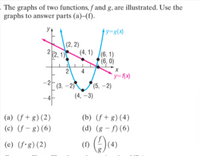
Calculus: Early Transcendentals
8th Edition
ISBN: 9781285741550
Author: James Stewart
Publisher: Cengage Learning
expand_more
expand_more
format_list_bulleted
Question

Transcribed Image Text:The graphs of two functions, f and g, are illustrated. Use the
graphs to answer parts (a)–(f).
y=g(x)
|(2, 2)
(4, 1) (6, 1)
(6, 0)
22, 1)
2
(3, –2)
(5, –2)
(4, –3)
(a) (f+ g)(2)
(b) (f + g) (4)
(c) (f – g) (6)
(d) (g – f) (6)
() ()(4)
(e) (f•g)(2)
2.
Expert Solution
This question has been solved!
Explore an expertly crafted, step-by-step solution for a thorough understanding of key concepts.
This is a popular solution
Trending nowThis is a popular solution!
Step by stepSolved in 3 steps with 2 images

Knowledge Booster
Similar questions
- Consider the following functions. f={(−2,1),(2,−4),(4,−4),(−1,1)}f={(−2,1),(2,−4),(4,−4),(−1,1)} and g={(−1,−4),(2,1)}g={(−1,−4),(2,1)} Step 2 of 4 : Find (f−g)(2)(f−g)(2).arrow_forwardFind the domain of the function f(x) = V-z 37 + 4arrow_forwardThe table below describes one linear function, f(x). A second linear function is defined by g(x)=−2x+5. What are the y-intercepts of the two functions? x −2 −1 0 1 2 f(x) 3 0 −3 −6 −9 The y-intercept of f(x) is (0,−3), and the y-intercept of g(x) is (0,−2). The y-intercept of f(x) is (0,−3), and the y-intercept of g(x) is (0,5). The y-intercept of f(x) is (0,−1), and the y-intercept of g(x) is (0,5). The y-intercept of f(x) is (0,−1), and the y-intercept of g(x) is (0,−2).arrow_forward
- The function f(x) has been transformed to y = -2f(-x+3)+1, which has resulted in the mapping of (4, -2) to Select one: O a. (-5,5) O b. (-1,5) O c. (-7,5) O d. (11, -3)arrow_forwardPlease help me with number 3arrow_forwardWrite the function as a composition of two functions. 1 2 y= (x² +8x) ³ - 7(x² +8x)³ +3 x² + 8x) ³ Choose the correct answer below. O A. O B. O C. 1 2 f f(x)=x² + 8x and g(x)=x³ - 7x³ +3, then y = f[g(x)]. 3 3 If f(x) = x³ - 7x² +3 and g(x)=x² +8x, then y = f[g(x)]. 1 2 If f(x) = 8x³ - 56x³ +3 and g(x)=x², then y = f[g(x)]. 1 2 OD. If f(x)=x If f(x)=x³ - 7x³ +3 and g(x)=x² + 8x, then y = f[g(x)].arrow_forward
- Please answer this WITHOUT A CALCULATOR. Your answer must match ONE of the answer choices. there is only ONE solution. If your answer is none of these choices than your answer is wrong and please check your math.arrow_forwardGraph both functions on one set of axes. f(x) = (3) * O -4 4 and g(x) = 1.5* -2 -2 y 2 y 6 4 2 f 2 2 4 X X 4 -2 -2 y 6 4 2 y 6 4 2 2 2 g 4 4 X Xarrow_forwardA(x) is a quoadratic function. B(x) is a quadratic function. What type of polynomial function is A(x) ·B(x)? 1. 2. A(x) is a linear function. B(x) is a linear function. What type of polynomial function is A(x) · B(x)?arrow_forward
- The graphs of two functions are shown below. Evaluate the function at the given values of x, if possible. a) (f-g)(-1), b) (f∙g)(-2), c) (g/f)(2), d) (fog)(-1), e) (gof)(-2)arrow_forwardThe length of a rectangle is 4 feet more than 3 times the width. (A = { x w and P = 2l + 2w) (a) Express the area A as a function of the width w. O A = {w square units (2 O A(t) 48 square units 3 3 O A(w) = 3w2 - 4w square units A(w) 4w² + 3w square units O A(w) = 3w2 + 4w square units (b) Express the perimeter P as a function of the length {. O P() =D 을(? - 1) units O P(w) = 8w + 8 units O P(t) = 8l + 8 units O P(t) = -3 8 units O P(t) = 1 unitsarrow_forwardThe transformation of a function f(x)f(x) into a function g(x)g(x) is given by g(x) = Af(Bx + H) + K g(x) — Af(Ba + н) + К. where the constants • AA vertically scales the function. (negative A reflects the function about the x-axis.) • BB horizontally scales the function. (negative B reflects the function about the y-axis.) • H horizontally shifts the function. • K vertically shifts the function. Transform f(x) into g(x) where the transformation is g(x) = - 2 · f(x + 2) - 2 The function f(x) is shown below in red. Graph the transformed function g(x) by first placing a dot at each end point of the new transformed function and then click on the "line segment" button and connect the two blue dots. (Hint: Transform the function by applying the constants in this order: H, B, A, K.) 4 -б -5 -4 -3 -2 -7 6 -1 -2 -3 -4 -5 |-6+arrow_forward
arrow_back_ios
arrow_forward_ios
Recommended textbooks for you
 Calculus: Early TranscendentalsCalculusISBN:9781285741550Author:James StewartPublisher:Cengage Learning
Calculus: Early TranscendentalsCalculusISBN:9781285741550Author:James StewartPublisher:Cengage Learning Thomas' Calculus (14th Edition)CalculusISBN:9780134438986Author:Joel R. Hass, Christopher E. Heil, Maurice D. WeirPublisher:PEARSON
Thomas' Calculus (14th Edition)CalculusISBN:9780134438986Author:Joel R. Hass, Christopher E. Heil, Maurice D. WeirPublisher:PEARSON Calculus: Early Transcendentals (3rd Edition)CalculusISBN:9780134763644Author:William L. Briggs, Lyle Cochran, Bernard Gillett, Eric SchulzPublisher:PEARSON
Calculus: Early Transcendentals (3rd Edition)CalculusISBN:9780134763644Author:William L. Briggs, Lyle Cochran, Bernard Gillett, Eric SchulzPublisher:PEARSON Calculus: Early TranscendentalsCalculusISBN:9781319050740Author:Jon Rogawski, Colin Adams, Robert FranzosaPublisher:W. H. Freeman
Calculus: Early TranscendentalsCalculusISBN:9781319050740Author:Jon Rogawski, Colin Adams, Robert FranzosaPublisher:W. H. Freeman
 Calculus: Early Transcendental FunctionsCalculusISBN:9781337552516Author:Ron Larson, Bruce H. EdwardsPublisher:Cengage Learning
Calculus: Early Transcendental FunctionsCalculusISBN:9781337552516Author:Ron Larson, Bruce H. EdwardsPublisher:Cengage Learning

Calculus: Early Transcendentals
Calculus
ISBN:9781285741550
Author:James Stewart
Publisher:Cengage Learning

Thomas' Calculus (14th Edition)
Calculus
ISBN:9780134438986
Author:Joel R. Hass, Christopher E. Heil, Maurice D. Weir
Publisher:PEARSON

Calculus: Early Transcendentals (3rd Edition)
Calculus
ISBN:9780134763644
Author:William L. Briggs, Lyle Cochran, Bernard Gillett, Eric Schulz
Publisher:PEARSON

Calculus: Early Transcendentals
Calculus
ISBN:9781319050740
Author:Jon Rogawski, Colin Adams, Robert Franzosa
Publisher:W. H. Freeman


Calculus: Early Transcendental Functions
Calculus
ISBN:9781337552516
Author:Ron Larson, Bruce H. Edwards
Publisher:Cengage Learning